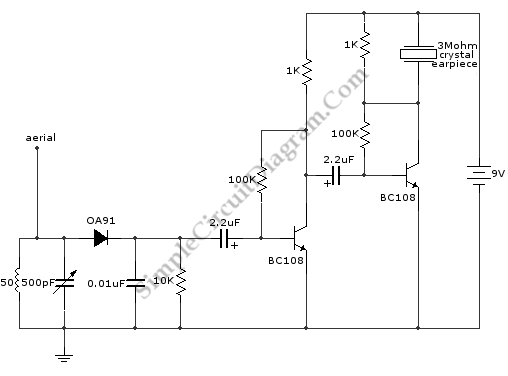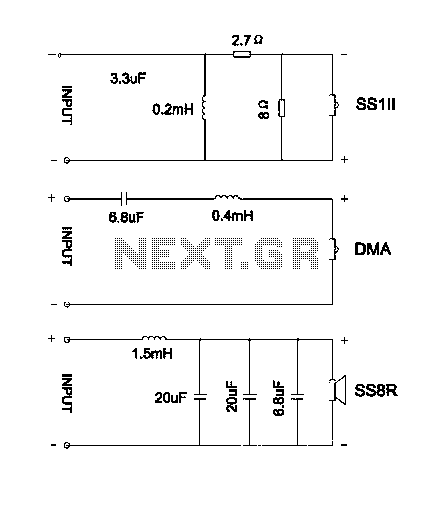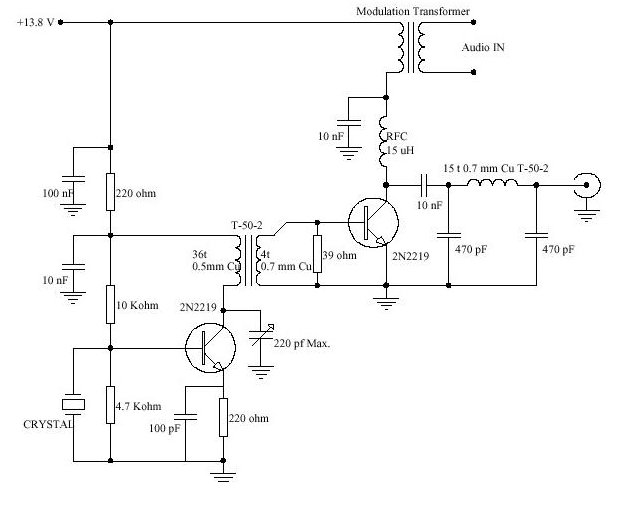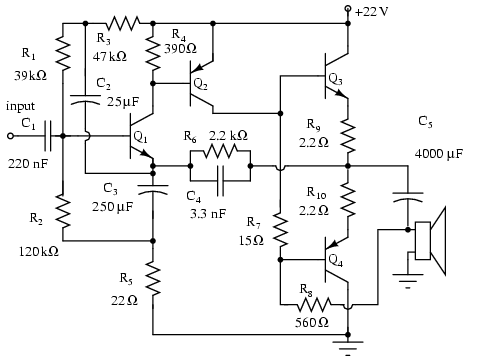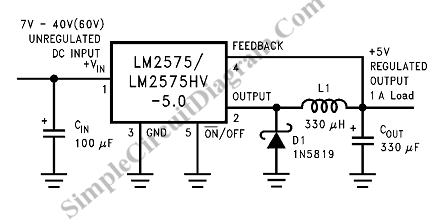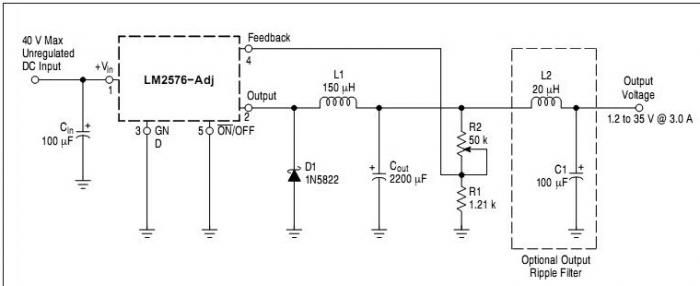
Simple preamplifier circuits by transistors
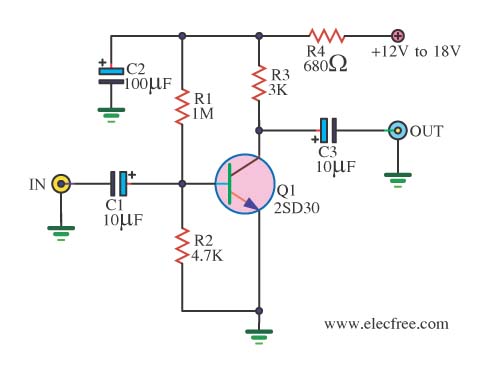
When there is a need to amplify audio signals from various sources before they reach a custom amplifier, a preamplifier (or preamp) is typically employed. This document suggests a specific circuit that is interesting due to its use of a single transistor (which can be replaced with various types such as C1815, C945, or C828). The circuit is simple and effective, making it convenient for novice users. It features a stereo PCB design, with input from a CD player and direct output to an amplifier. The preamplifier circuit enhances audio signals from sources that may have low output levels, such as tape players or tuners, where the signal strength may be in microvolts (µV). The preamp boosts this signal to a millivolt (mV) range suitable for a power amplifier, improving amplification efficiency. The circuit operates on a 9-volt power supply, utilizing transistors Q1 and Q2 in a direct coupling configuration for optimal signal transmission. The audio input is coupled through capacitor C1 to filter out any DC voltage, allowing the audio signal to enter the base of Q1, where it is amplified. The signal is then passed to Q2 for further amplification and stability. The output is taken from the collector pin of Q2 through coupling capacitor C6. A portion of the output signal is fed back through capacitors C4 and C3, and resistor R3 to the emitter pin of Q1, enhancing frequency response. This preamplifier circuit can be powered by a 6-12 volt supply with a minimum current of 2-3 mA, capable of boosting signal strength up to 2 volts, making it suitable for driving a power amplifier. The frequency response ranges from 70 Hz to 45 kHz at -3 dB, with distortion levels below 0.1%. The circuit includes biasing resistors R1 and R2 for Q1, and R6/R5 for gain adjustment. Capacitor C3 improves high-frequency response, while resistor R9 provides power to a condenser microphone if the preamp is not integrated with it.
The preamplifier circuit described is a fundamental building block in audio signal processing, designed to enhance weak audio signals for better compatibility with power amplifiers. The choice of a single transistor design simplifies the circuit while maintaining effectiveness, making it an excellent choice for beginners. The use of standard transistor models allows for easy sourcing and replacement, ensuring that the circuit can be assembled with readily available components.
The circuit's functionality is further enhanced by the careful selection of coupling capacitors, which serve to block DC components while allowing AC audio signals to pass through. This feature is critical in preventing any unwanted DC offset from affecting the performance of subsequent stages in the audio chain. The feedback mechanism implemented via capacitors and resistors ensures that the circuit maintains a stable gain across a wide frequency range, resulting in clear and distortion-free audio output.
In terms of power supply requirements, the circuit's flexibility in operating between 6 to 12 volts makes it adaptable for various applications, whether in home audio systems or portable devices. The low current consumption of 2-3 mA indicates that the circuit can be powered efficiently, making it suitable for battery-operated devices.
Overall, this preamplifier circuit exemplifies a robust solution for audio signal amplification, providing the necessary gain and frequency response for high-quality audio output while remaining accessible for novice engineers and hobbyists.When you want to enlarge sound signal from all source before costume amplify. Usual use Pre Amplifier or Pre Amp. Today I begs for to suggest again the one circuit. That interesting because of use Transistor just one ( the number replaces many the number such as C1815 or C945 or C828, etc. ) The circuit easily and still be usable well. convenient for a novice as an example PCB be the character Stereo. Wasp Input from the CD player and Output with the amplifier immediately. Request enjoy please yes. The preamplifier circuit is a circuit that extends the signal from the source sound to signal the strength to go into a power amplifier circuit to trigger the required sector preamplifier is also due to signal from the source voice Some levels. sounds very light, such as tape or tuner, some will have strength of signals in the heart uV is required to use the preamplifier circuit expanded signal strength to strength in the area mV to access the power amplifier for amplifier efficiency.
By entering into power supply 9volt circuit Q1 and Q2 to a direct coupling circuit to transmit better. When the signal input through the C1 coupling into the signal to Q1. Amplifier to a level of C to stand out in Q2 into the amplifier once again to provide better stability.
Then signal to leave the output pin C of Q2 through C6 coupling signal from output and the output signal a part of Q2 will feed black feedback through to the C4, C3 and R3 comes to the pin E in Q1 in order to help the range of frequency response. Pre amplifier circuit with transistors can be used to supply source from 6-12Volt the current minimum is 2-3 mA and can extend the signal strength from up to 2 Volt, which can This will signal the driver to easily power amplifier and frequency response can be frequency response from 70 Hz 45 kHz at -3 dB and distortion less than 0.
1%. By entering into power supply circuit and one audio Input. The signal is coupling through C1 to prevent DC Voltage to Harry and then audio goes into the leg B of Q1 to amplify signals to forces up to the one with the R1 and R2 is the organized bias for Q1 is Q1. and Q2 is connected to a direct coupling circuit broadcast better. Then the signal was expanded to export the C leg of Q2 and through C5 coupling signal to smooth out and send it to Su output gain of the circuit, which can be set from the R6/R5 C3 acts as a wizard.
high frequency response better. R9 is connected to the circuit when the circuit for use in the nature of the pre mic R9 acts as the power supply to the mic condenser used if the nature of the pre amp is not integrated into the R9. 🔗 External reference
The preamplifier circuit described is a fundamental building block in audio signal processing, designed to enhance weak audio signals for better compatibility with power amplifiers. The choice of a single transistor design simplifies the circuit while maintaining effectiveness, making it an excellent choice for beginners. The use of standard transistor models allows for easy sourcing and replacement, ensuring that the circuit can be assembled with readily available components.
The circuit's functionality is further enhanced by the careful selection of coupling capacitors, which serve to block DC components while allowing AC audio signals to pass through. This feature is critical in preventing any unwanted DC offset from affecting the performance of subsequent stages in the audio chain. The feedback mechanism implemented via capacitors and resistors ensures that the circuit maintains a stable gain across a wide frequency range, resulting in clear and distortion-free audio output.
In terms of power supply requirements, the circuit's flexibility in operating between 6 to 12 volts makes it adaptable for various applications, whether in home audio systems or portable devices. The low current consumption of 2-3 mA indicates that the circuit can be powered efficiently, making it suitable for battery-operated devices.
Overall, this preamplifier circuit exemplifies a robust solution for audio signal amplification, providing the necessary gain and frequency response for high-quality audio output while remaining accessible for novice engineers and hobbyists.When you want to enlarge sound signal from all source before costume amplify. Usual use Pre Amplifier or Pre Amp. Today I begs for to suggest again the one circuit. That interesting because of use Transistor just one ( the number replaces many the number such as C1815 or C945 or C828, etc. ) The circuit easily and still be usable well. convenient for a novice as an example PCB be the character Stereo. Wasp Input from the CD player and Output with the amplifier immediately. Request enjoy please yes. The preamplifier circuit is a circuit that extends the signal from the source sound to signal the strength to go into a power amplifier circuit to trigger the required sector preamplifier is also due to signal from the source voice Some levels. sounds very light, such as tape or tuner, some will have strength of signals in the heart uV is required to use the preamplifier circuit expanded signal strength to strength in the area mV to access the power amplifier for amplifier efficiency.
By entering into power supply 9volt circuit Q1 and Q2 to a direct coupling circuit to transmit better. When the signal input through the C1 coupling into the signal to Q1. Amplifier to a level of C to stand out in Q2 into the amplifier once again to provide better stability.
Then signal to leave the output pin C of Q2 through C6 coupling signal from output and the output signal a part of Q2 will feed black feedback through to the C4, C3 and R3 comes to the pin E in Q1 in order to help the range of frequency response. Pre amplifier circuit with transistors can be used to supply source from 6-12Volt the current minimum is 2-3 mA and can extend the signal strength from up to 2 Volt, which can This will signal the driver to easily power amplifier and frequency response can be frequency response from 70 Hz 45 kHz at -3 dB and distortion less than 0.
1%. By entering into power supply circuit and one audio Input. The signal is coupling through C1 to prevent DC Voltage to Harry and then audio goes into the leg B of Q1 to amplify signals to forces up to the one with the R1 and R2 is the organized bias for Q1 is Q1. and Q2 is connected to a direct coupling circuit broadcast better. Then the signal was expanded to export the C leg of Q2 and through C5 coupling signal to smooth out and send it to Su output gain of the circuit, which can be set from the R6/R5 C3 acts as a wizard.
high frequency response better. R9 is connected to the circuit when the circuit for use in the nature of the pre mic R9 acts as the power supply to the mic condenser used if the nature of the pre amp is not integrated into the R9. 🔗 External reference
